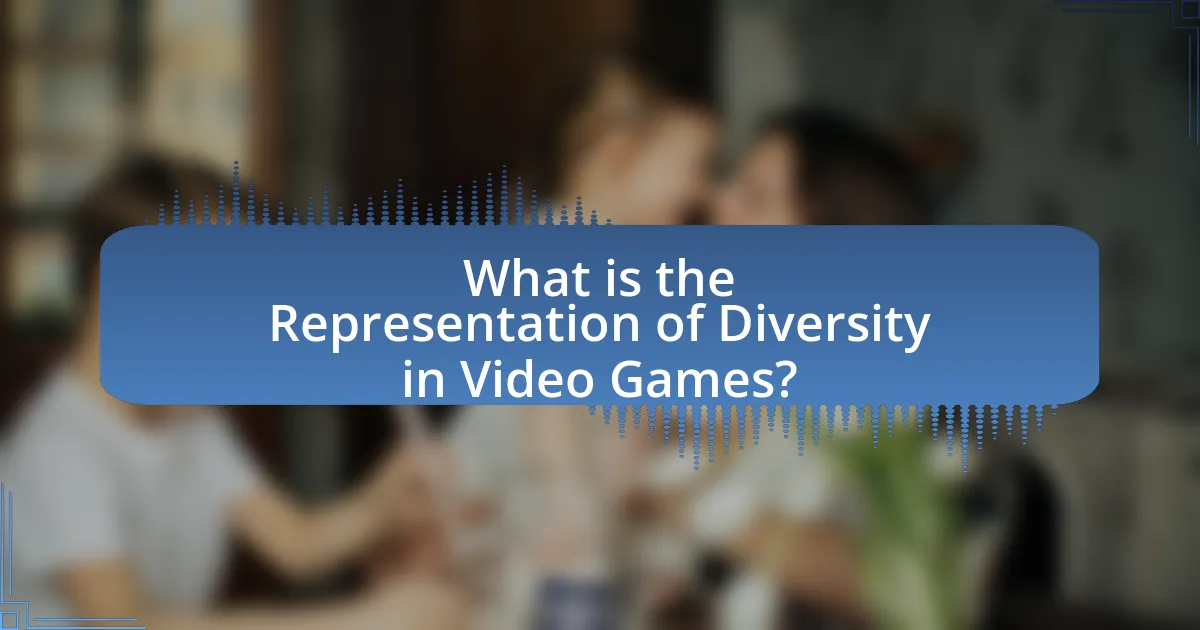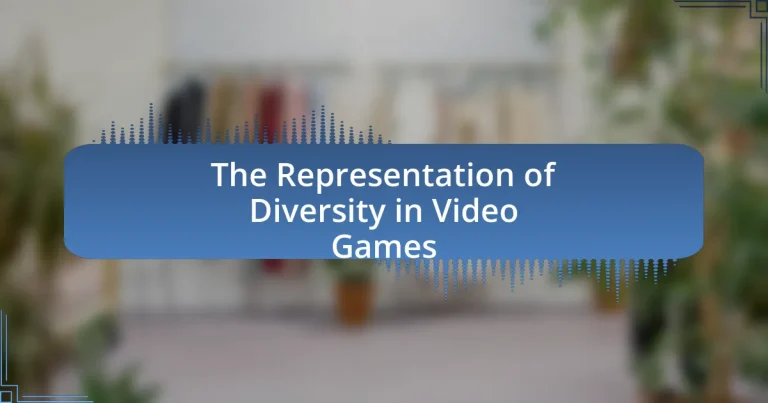The representation of diversity in video games encompasses the inclusion and portrayal of various identities, cultures, and experiences within gaming narratives and characters. This article examines the evolution of diversity in video games, highlighting its importance for creativity, player engagement, and inclusivity. It discusses the impact of diverse representation on player experience, the consequences of a lack of diversity, and the various forms of diversity represented, including racial, gender, sexual orientation, and disability diversity. Additionally, the article addresses the challenges in achieving diversity, successful examples of representation, and best practices for developers to ensure authentic and inclusive gaming experiences.

What is the Representation of Diversity in Video Games?
The representation of diversity in video games refers to the inclusion and portrayal of various identities, cultures, and experiences within gaming narratives and characters. This representation has evolved significantly, with many games now featuring protagonists from diverse racial, ethnic, gender, and sexual orientation backgrounds. For instance, games like “The Last of Us Part II” and “Overwatch” showcase LGBTQ+ characters and narratives, reflecting a broader societal push for inclusivity. Research indicates that diverse representation can enhance player engagement and empathy, as seen in studies by the International Game Developers Association, which highlight that 70% of players appreciate games that reflect diverse experiences.
Why is diversity important in video games?
Diversity is important in video games because it enhances creativity, broadens audience appeal, and fosters inclusivity. Diverse characters and narratives allow for a richer storytelling experience, which can attract a wider range of players. For instance, a study by the International Game Developers Association found that 70% of gamers prefer games that feature diverse characters, indicating a strong demand for representation. Additionally, diverse teams in game development have been shown to produce more innovative ideas, as varied perspectives lead to unique gameplay mechanics and storylines. This not only improves the gaming experience but also reflects the global society in which players live.
How does diversity impact player experience?
Diversity significantly enhances player experience by fostering inclusivity and relatability within video games. When games feature diverse characters and narratives, players from various backgrounds feel represented, which can lead to increased emotional investment and engagement. Research indicates that representation in media, including video games, positively affects players’ self-esteem and sense of belonging. For instance, a study published in the Journal of Communication found that players who identified with diverse characters reported higher levels of enjoyment and connection to the game. This connection not only enriches the gaming experience but also promotes empathy and understanding among players, contributing to a more vibrant gaming community.
What are the consequences of a lack of diversity?
A lack of diversity in video games leads to limited perspectives and reinforces stereotypes. This absence can result in a narrow representation of characters and narratives, which alienates diverse audiences and diminishes the overall gaming experience. Research indicates that games lacking diverse characters often fail to resonate with players from different backgrounds, leading to decreased engagement and sales. For instance, a study by the International Game Developers Association found that 70% of gamers prefer games that reflect a variety of cultures and identities. Consequently, the gaming industry risks losing a significant market share by not embracing diversity.
What forms of diversity are represented in video games?
Video games represent various forms of diversity, including racial, gender, sexual orientation, and disability diversity. Racial diversity is evident in the inclusion of characters from different ethnic backgrounds, such as African American, Asian, and Hispanic protagonists in titles like “Overwatch” and “Street Fighter.” Gender diversity is showcased through strong female characters, such as Aloy in “Horizon Zero Dawn” and Lara Croft in “Tomb Raider,” challenging traditional gender roles. Sexual orientation diversity is represented through LGBTQ+ characters and storylines, as seen in games like “The Last of Us Part II,” which features a prominent lesbian relationship. Disability diversity is increasingly acknowledged, with games like “Celeste” addressing mental health and featuring characters with disabilities. These representations reflect a broader societal push for inclusivity and recognition of diverse identities in media.
How are racial and ethnic diversities portrayed?
Racial and ethnic diversities in video games are portrayed through character design, narrative roles, and cultural representation. Many games feature characters from various racial and ethnic backgrounds, reflecting real-world diversity. For instance, games like “Overwatch” and “Street Fighter” showcase characters with distinct cultural identities, which enhances player engagement and representation. Research indicates that diverse representation can positively impact players’ perceptions and attitudes towards different cultures, as seen in studies by the International Game Developers Association, which highlight the importance of inclusivity in gaming narratives.
What about gender representation in video games?
Gender representation in video games has historically been skewed, with male characters dominating the landscape. Studies indicate that only 18% of video game protagonists are female, highlighting a significant gender disparity. This lack of representation can perpetuate stereotypes and limit the diversity of narratives within the gaming industry. Furthermore, research from the International Game Developers Association (IGDA) shows that women make up approximately 22% of the game development workforce, which contributes to the underrepresentation of female characters in games.
How is LGBTQ+ representation handled in gaming narratives?
LGBTQ+ representation in gaming narratives is increasingly recognized and integrated, with many games featuring LGBTQ+ characters and storylines that reflect diverse identities. For instance, titles like “The Last of Us Part II” and “Life is Strange” prominently showcase LGBTQ+ relationships and experiences, contributing to a broader acceptance and visibility of these communities in gaming. Research indicates that 70% of gamers support LGBTQ+ representation, highlighting a demand for inclusivity in narratives. This shift is further evidenced by the growing number of awards recognizing LGBTQ+ themes in games, such as the GLAAD Media Awards, which honor media that accurately represents LGBTQ+ individuals.
How has the representation of diversity evolved over time?
The representation of diversity in video games has evolved significantly from the early days of gaming to the present. Initially, video games predominantly featured white male protagonists, with limited representation of women and people of color. For example, early arcade games like “Pac-Man” and “Space Invaders” showcased simplistic characters that lacked depth and diversity.
Over time, the gaming industry began to recognize the importance of inclusivity, leading to more diverse character designs and narratives. The 1990s saw the introduction of characters like Liu Kang in “Mortal Kombat,” who represented Asian culture, and games like “Tomb Raider,” which featured Lara Croft as a strong female lead.
In the 2000s and beyond, the push for diversity gained momentum, with titles such as “The Last of Us” and “Overwatch” showcasing a range of characters from different backgrounds, genders, and sexual orientations. This shift was influenced by broader societal movements advocating for representation and equality, as well as the growing recognition that diverse narratives resonate with a wider audience.
Research indicates that diverse representation in media, including video games, can positively impact players’ perceptions and attitudes towards different cultures and identities. A study published in the “Journal of Communication” by authors Sarah J. Jackson and others found that exposure to diverse characters can reduce stereotypes and foster empathy among players.
Overall, the evolution of diversity in video games reflects a broader cultural shift towards inclusivity, with ongoing efforts to ensure that all players see themselves represented in the gaming world.
What historical trends can be observed in video game diversity?
Historical trends in video game diversity show a gradual increase in representation across various demographics, including gender, race, and sexual orientation. In the early years of gaming, characters were predominantly white males, with limited representation of women and people of color. For instance, the 1980s and 1990s featured few female protagonists, with titles like “Super Mario Bros.” primarily showcasing male characters.
By the 2000s, the industry began to shift, with games like “Tomb Raider” introducing strong female leads, and titles such as “Street Fighter” and “Tekken” featuring diverse character rosters. The rise of indie games in the 2010s further accelerated this trend, as developers sought to tell unique stories that included LGBTQ+ characters and narratives, exemplified by games like “Life is Strange” and “Celeste.”
Recent studies, such as the 2021 “Video Game Diversity Report” by the International Game Developers Association, indicate that 50% of game developers identify as women or non-binary, reflecting a more inclusive industry. This evolution highlights a significant shift towards greater diversity in character representation and storytelling within video games.
How have player expectations changed regarding diversity?
Player expectations regarding diversity in video games have significantly increased, with a growing demand for authentic representation of various identities, cultures, and experiences. This shift is evidenced by the rise of diverse characters and narratives in popular titles, reflecting a broader societal push for inclusivity. For instance, a 2021 survey by the International Game Developers Association found that 70% of gamers believe that diversity in games enhances their overall experience, indicating a clear expectation for developers to prioritize representation. Additionally, the success of games like “The Last of Us Part II,” which features LGBTQ+ characters and complex narratives around race and gender, demonstrates that players are not only expecting diversity but are also willing to support titles that deliver on these expectations.
What challenges exist in achieving diversity in video games?
Achieving diversity in video games faces several challenges, including industry gatekeeping, lack of representation in development teams, and market pressures. Industry gatekeeping often limits opportunities for diverse creators, resulting in a narrow range of perspectives and narratives. Additionally, when development teams lack diversity, the resulting games may not authentically represent varied cultures and experiences. Market pressures can lead to a focus on established franchises and familiar themes, discouraging innovation and the inclusion of diverse characters and stories. According to a 2021 report by the International Game Developers Association, only 22% of game developers identify as women, and even fewer belong to underrepresented racial and ethnic groups, highlighting the need for more inclusive hiring practices to address these challenges.
What are the barriers to diverse character creation?
Barriers to diverse character creation in video games include industry stereotypes, lack of representation among developers, and financial risks associated with broadening character diversity. Industry stereotypes often lead to the reinforcement of existing tropes, limiting the scope of character design. A study by the International Game Developers Association (IGDA) in 2021 found that only 22% of game developers identified as women, which contributes to a narrow perspective in character creation. Additionally, publishers may perceive diverse characters as less marketable, leading to hesitance in funding projects that feature them. This financial risk is supported by market research indicating that games with diverse characters can face challenges in reaching mainstream audiences, further discouraging developers from pursuing innovative character designs.
How do industry practices affect diversity representation?
Industry practices significantly affect diversity representation by shaping hiring processes, content creation, and marketing strategies. For instance, companies that prioritize inclusive hiring practices tend to have more diverse teams, which can lead to a broader range of perspectives in game development. Research from the International Game Developers Association (IGDA) indicates that diverse teams are more likely to create content that resonates with a wider audience, enhancing representation in video games. Furthermore, industry standards that promote diversity in storytelling and character design can lead to more authentic and varied portrayals of different cultures and identities, as evidenced by the increasing number of games featuring diverse protagonists and narratives.
How can developers improve diversity in video games?
Developers can improve diversity in video games by actively incorporating diverse characters, narratives, and perspectives into their games. This can be achieved through hiring diverse teams that reflect a variety of backgrounds, experiences, and cultures, which enhances creativity and authenticity in storytelling. Research indicates that games featuring diverse characters not only attract a broader audience but also lead to higher sales; for instance, a 2020 report by the International Game Developers Association found that 70% of players prefer games with diverse representation. Additionally, developers can engage with communities to understand their experiences and expectations, ensuring that the representation is respectful and accurate.
What strategies can be employed for better representation?
To achieve better representation in video games, developers can implement inclusive character design, diverse storytelling, and collaborative input from underrepresented communities. Inclusive character design involves creating characters that reflect a wide range of identities, including race, gender, and sexual orientation, which can enhance relatability and engagement for diverse audiences. Diverse storytelling ensures that narratives encompass various cultural perspectives and experiences, allowing players to connect with different backgrounds. Collaborative input from underrepresented communities can be facilitated through focus groups or partnerships with cultural consultants, ensuring authenticity and sensitivity in representation. Research indicates that games with diverse characters and narratives can lead to increased player satisfaction and broader market appeal, as seen in titles like “The Last of Us Part II,” which received acclaim for its representation of LGBTQ+ characters and themes.
How can player feedback influence diversity initiatives?
Player feedback can significantly influence diversity initiatives by providing developers with direct insights into player experiences and expectations regarding representation. When players express their views on character diversity, storylines, and cultural representation, developers can identify gaps and areas for improvement. For instance, a study by the International Game Developers Association found that 70% of players believe that diverse representation enhances their gaming experience, indicating a strong demand for inclusivity. This feedback can lead to more diverse character designs, narratives that reflect various cultures, and inclusive gameplay mechanics, ultimately fostering a gaming environment that resonates with a broader audience.
What are some examples of successful diverse representation in video games?
Successful diverse representation in video games includes titles like “The Last of Us Part II,” which features a prominent LGBTQ+ character, Ellie, and explores themes of identity and love. Another example is “Overwatch,” which showcases a diverse cast of characters from various ethnic backgrounds, including Tracer, a British character, and Lucio, a Brazilian character, promoting inclusivity. Additionally, “Assassin’s Creed: Odyssey” allows players to choose a female protagonist, Kassandra, and incorporates elements of ancient Greek culture, highlighting gender diversity and historical representation. These games have been recognized for their efforts in portraying diverse identities and experiences, contributing to a more inclusive gaming landscape.
Which games are recognized for their diverse characters?
Games recognized for their diverse characters include “Overwatch,” “The Last of Us Part II,” and “Street Fighter V.” “Overwatch” features a roster of heroes from various ethnic backgrounds, sexual orientations, and gender identities, promoting inclusivity. “The Last of Us Part II” showcases a range of characters, including LGBTQ+ representation and characters of different races, enhancing narrative depth and relatability. “Street Fighter V” includes fighters from multiple countries, each with unique cultural backgrounds, reflecting global diversity in its character design. These games exemplify the industry’s commitment to representing diverse identities and experiences.
How do these games impact the gaming community?
These games significantly enhance the gaming community by promoting inclusivity and representation of diverse identities. By featuring characters from various backgrounds, cultures, and experiences, they foster a sense of belonging among players who may have previously felt marginalized. Research indicates that games with diverse representation can lead to increased player engagement and satisfaction, as seen in titles like “The Last of Us Part II,” which received acclaim for its portrayal of LGBTQ+ characters and themes. This representation not only validates the experiences of underrepresented groups but also educates the broader gaming audience, contributing to a more inclusive and understanding community.
What best practices should developers follow for inclusive representation?
Developers should prioritize diverse character design, inclusive storytelling, and community engagement to ensure inclusive representation in video games. Diverse character design involves creating characters that reflect various ethnicities, genders, sexual orientations, and abilities, which enhances relatability and broadens audience appeal. Inclusive storytelling requires narratives that authentically represent different cultures and experiences, avoiding stereotypes and promoting empathy. Community engagement entails actively seeking feedback from diverse player groups during the development process, which can lead to more authentic and respectful representation. Research indicates that games with diverse representation can lead to increased player satisfaction and market success, as seen in titles like “The Last of Us Part II,” which received acclaim for its inclusive approach.
How can developers ensure authentic representation?
Developers can ensure authentic representation by actively involving diverse voices in the game development process. This includes hiring individuals from various backgrounds, cultures, and experiences to contribute to storytelling, character design, and gameplay mechanics. Research indicates that games developed with input from diverse teams are more likely to resonate with a broader audience and reflect authentic experiences, as seen in titles like “The Last of Us Part II,” which received praise for its nuanced portrayal of LGBTQ+ characters. By prioritizing inclusivity and representation in their teams, developers can create more relatable and authentic gaming experiences.
What role does community engagement play in diversity efforts?
Community engagement is crucial in diversity efforts as it fosters inclusive dialogue and collaboration among diverse groups. By actively involving community members in decision-making processes, organizations can better understand the unique perspectives and needs of various demographics. This engagement leads to more representative content and practices, as evidenced by initiatives in the gaming industry where developers have incorporated feedback from diverse player communities to create more inclusive narratives and characters. For instance, the success of games like “The Last of Us Part II” demonstrates how community input can enhance representation and resonate with a broader audience, ultimately driving positive change in diversity representation within video games.


